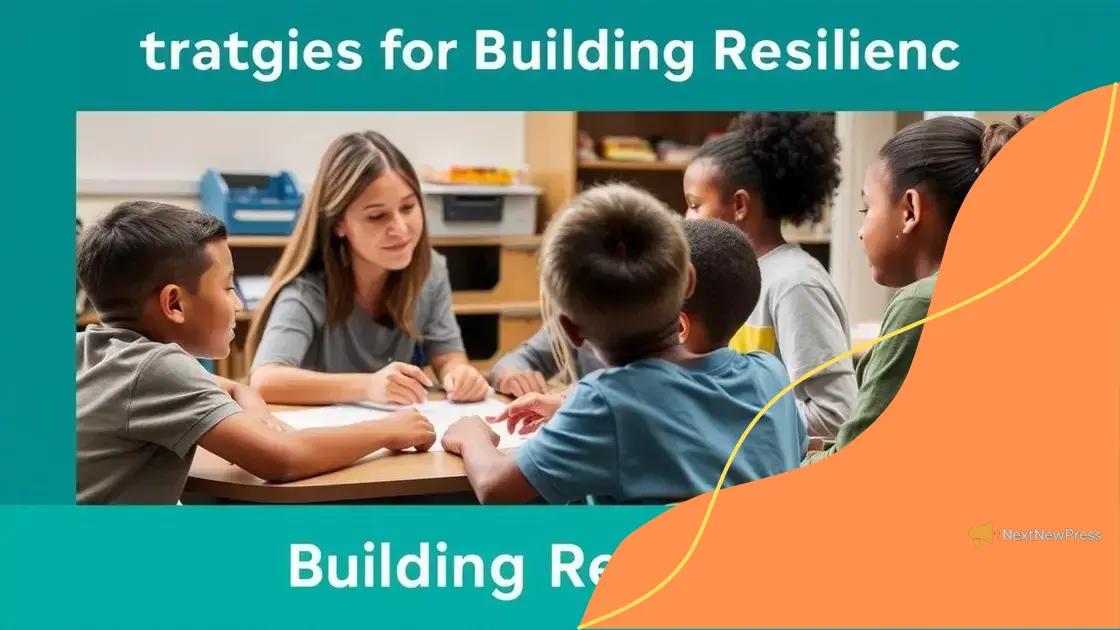The importance of cultivating resilience in students

The importance of cultivating resilience in students lies in enhancing their ability to overcome challenges, improve academic performance, and develop strong emotional health through supportive environments and effective coping strategies.
The importance of cultivating resilience in students goes beyond just academic success. It equips them to face challenges and bounce back from setbacks. Have you ever wondered how resilience impacts their daily lives? Let’s dive into this crucial aspect of education.
Understanding resilience in education
Understanding resilience in education is crucial for helping students thrive in various situations. It allows them to navigate challenges effectively and adapt to changes. By developing resilience, students can overcome difficulties that may arise throughout their education.
The definition of resilience in education
Resilience in education refers to the ability of students to bounce back from setbacks, adapt positively to challenges, and maintain motivation even when faced with obstacles. This capability is not inherent; rather, it can be nurtured and developed through various approaches.
Key factors influencing resilience
Several factors play a significant role in enhancing resilience among students. These include:
- Supportive relationships: Positive interactions with teachers, family, and peers can provide emotional backup.
- Positive school environment: A safe and inclusive atmosphere promotes a sense of belonging.
- Growth mindset: Encouraging a mindset that embraces challenges fosters resilience.
As we delve deeper into the importance of building resilience, we also note that it can lead to improved academic performance. Students who exhibit resilience tend to be more engaged in their learning activities. They embrace difficulties as opportunities for growth rather than as threats. The educational framework can significantly impact how students perceive challenges.
Implementing resilience-building strategies in the classroom
Teachers are at the forefront of fostering resilience. By incorporating specific strategies, they can create an environment that promotes these skills:
- Encourage open communication: Allowing students to express their feelings helps them to work through challenges.
- Teach problem-solving skills: Teaching students how to approach problems empowers them to handle obstacles.
- Provide feedback: Constructive feedback helps students learn from mistakes without discouragement.
In addition, integrating activities that focus on social-emotional learning can substantially boost a student’s resilience. For example, group projects that require teamwork can help build strong relationships, enhancing their ability to collaborate and face challenges collectively. Overall, resilience in education is not just about enduring stress; it’s about thriving amid challenges.
Benefits of resilience for students
The benefits of resilience for students are wide-ranging and significantly impact their academic and personal lives. When students develop resilience, they tend to perform better in school, manage stress effectively, and build stronger relationships with peers and teachers. Resilience is not just a skill; it’s an essential trait that shapes how students navigate their educational experiences.
Improved academic performance
Research shows that resilient students often demonstrate higher academic performance. They approach challenges with a positive mindset and view failure as a learning opportunity. This outlook not only helps them succeed academically but also boosts their confidence.
Stress management
One of the primary advantages of being resilient is enhanced stress management. Resilient students learn to cope with stressors and adapt to changing situations. They tend to utilize effective strategies, which can include:
- Seeking support: Reaching out to friends, family, or teachers for help.
- Practicing mindfulness: Engaging in activities that promote relaxation.
- Setting realistic goals: Establishing achievable targets to maintain motivation.
By using these strategies, students can navigate academic pressures, leading to a healthier school experience.
Stronger relationships
Another benefit of resilience is the ability to form strong relationships. Resilient students often communicate effectively and connect well with others. They understand the importance of teamwork and collaboration. The ability to build positive relationships enhances their social skills, which are crucial both in school and in life. Furthermore, resilient students can build a supportive network, making it easier for them to face challenges together.
In addition, resilience fosters independence. As students learn to tackle obstacles, they become more self-reliant and motivated. This independence enables them to take initiative in their learning and personal growth. Ultimately, cultivating resilience can help shape well-rounded individuals who are prepared to face life’s uncertainties.
Strategies for building resilience

Implementing effective strategies for building resilience in students is essential for their growth and success. These strategies empower them to cope with challenges and foster a positive school experience. By creating supportive environments and encouraging healthy behaviors, educators and parents can significantly impact students’ resilience.
Encouraging a growth mindset
One of the key strategies is to promote a growth mindset. This encourages students to view challenges as opportunities for growth rather than setbacks. When students believe they can improve with effort and practice, they become more willing to take risks in learning. Celebrate their effort rather than just the outcome. Acknowledging small victories helps build confidence.
Teaching coping skills
Another effective approach is teaching students specific coping skills. These skills can help them manage stress and navigate difficult situations. Some essential coping skills include:
- Problem-solving: Helping students learn to break down problems into manageable parts.
- Mindfulness: Practicing mindfulness techniques can help students stay grounded and focused.
- Emotional regulation: Teaching students how to recognize and manage their emotions is crucial for resilience.
Using role-playing scenarios in the classroom can also enhance their ability to cope with challenges by providing real-life contexts where they can apply these skills.
Fostering strong relationships
Promoting strong relationships among students, teachers, and parents is vital. Encourage teamwork and collaboration in projects, and create opportunities for students to connect with others. When students feel supported by their peers and teachers, they are more likely to share their challenges and seek help when needed. This sense of connection builds a safety net that enhances their resilience.
Additionally, integrating social-emotional learning into the curriculum can cultivate these supportive relationships. Incorporating activities that encourage communication and collaboration among students can boost their ability to face challenges.
The role of teachers in fostering resilience
The role of teachers in fostering resilience cannot be overstated. Teachers are pivotal in shaping students’ attitudes and behaviors toward challenges. They create environments that encourage growth and offer support during stressful times. When teachers model resilience, they inspire students to adopt similar attitudes in their own lives.
Creating a supportive classroom environment
One of the key responsibilities of teachers is to create a safe and supportive classroom atmosphere. This involves nurturing relationships with students, where they feel valued and heard. When students know that their teachers care about their well-being, they are more likely to take risks in their learning. A supportive environment also encourages open communication, allowing students to express their concerns and challenges.
Modeling resilience
Teachers can effectively foster resilience by modeling it themselves. They should share their own experiences of overcoming obstacles and the lessons learned from those situations. This approach not only humanizes teachers but also teaches students that setbacks are a normal part of life. When students see their teachers handle challenges with grace, they are more likely to adopt similar behaviors.
Providing constructive feedback
Another significant aspect of a teacher’s role is giving constructive feedback. This feedback should focus on effort, improvement, and strategies rather than just outcomes. By acknowledging the process of learning, teachers help students understand that growth takes time and persistence. Additionally, encouraging a growth mindset through praise reinforces the idea that abilities can be developed with practice.
Furthermore, implementing classroom activities that focus on teamwork can enhance students’ resilience. Group projects not only promote collaboration but also teach students how to support one another during challenges. When they work together, students learn invaluable lessons about empathy and shared success.
Parenting approaches to nurture resilience
Effective parenting approaches to nurture resilience are vital for helping children grow into adaptable and capable individuals. Parents play a key role in shaping their children’s ability to face challenges. By implementing specific strategies, parents can support their child’s journey towards developing resilience.
Encouraging independence
One essential approach is encouraging independence. Allowing children to make their own choices, even in small matters, fosters a sense of ownership over their decisions. This empowerment helps children gain confidence in their abilities to solve problems. When kids face minor challenges, parents should resist the urge to intervene immediately. Instead, guiding them to find solutions on their own promotes resilience.
Fostering a positive environment
Creating a positive environment at home significantly impacts a child’s resilience development. Parents should focus on cultivating a supportive atmosphere where children feel safe to express their feelings. Activities that promote family bonding, such as game nights or shared hobbies, help strengthen these relationships. When children know they have a support system, they are more equipped to handle difficulties.
Teaching coping strategies
Parents can also teach effective coping strategies. Children should learn how to manage their emotions and react to stressful situations. Some helpful strategies include:
- Deep breathing: Teaching children how to take deep breaths can help calm them during stressful moments.
- Problem-solving skills: Encouraging kids to think through problems can help them feel more in control.
- Positive self-talk: Teaching children to replace negative thoughts with positive affirmations can boost their confidence.
By incorporating these coping mechanisms into daily routines, parents can help children navigate challenges more effectively.
Finally, modeling resilience as parents is crucial. When children observe their parents facing difficulties with grace and determination, they learn valuable lessons about perseverance. Sharing personal experiences and how to overcome obstacles teaches children that setbacks are a normal part of life.
In conclusion, nurturing resilience in students is a collaborative effort that involves teachers, parents, and the broader school community. By implementing effective strategies such as encouraging independence, fostering strong relationships, and teaching coping mechanisms, we can equip students with the tools they need to face challenges confidently. Resilience not only enhances their academic performance but also supports their emotional well-being. Together, we can create an environment that fosters growth and enables our children to thrive.
FAQ – Frequently Asked Questions about Building Resilience in Students
What is resilience in education?
Resilience in education refers to a student’s ability to bounce back from challenges and adapt to difficult situations, enabling them to achieve success.
How can parents encourage resilience in their children?
Parents can encourage resilience by fostering independence, creating a positive environment, and teaching coping strategies for managing stress.
What role do teachers play in fostering resilience?
Teachers create supportive classroom environments, model resilience through their actions, and provide constructive feedback to help students develop resilience.
Why is resilience important for students?
Resilience is crucial for students because it improves their academic performance, helps manage stress, and builds stronger relationships with peers and adults.





